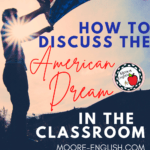Last week, I mentioned that my juniors were testing on The Great Gatsby, which got me thinking about some of my favorite lessons for Fitzgerald’s classic novel. Helping students conceptualize the American Dream is an essential part of teaching The Great Gatsby.
This post this post may contain affiliate links. Please read the Terms of Use.
Start with the Right Resource
One of my favorite ways to introduce the American Dream is with primary source articles that trace its development and evolution. The New York Times has a section called the Learning Network, which includes relevant articles for high school students, lessons for teachers, and appropriate clips and infographics. It’s a great resource, and even if you ignore the rest of this blog, you should check it out.
A few years ago, their weekly newsletter included a lesson called “I Dreamed a Dream in Time Gone By”, which included links to several articles from the New York Times, each one from a different time period and each one offering a different perspective on the American dream.
At the time, my students were getting ready to start The Great Gatsby, so I knew I was going to spend some time discussing the idea of the American Dream. The Learning Network’s resources proved invaluable in helping me introduce students to this concept and also provided an opportunity for students to interact with primary sources.
Steps to Introduce the American Dream
While the Learning Network provides its own lesson, I ended up doing this.
1. Collect Resources: I printed each of the articles linked to the Learning Network lesson. There were 11 articles in total, and each year I add another article to the pile to keep the conversation going. Each article is, itself, a primary source. To find additional articles, I visited Time and NPR. Most of the time I print the articles I want to use, but sometimes I link them on our class Google Classroom.
2. Read each article yourself because you will find that some articles are more complex than others.
3. Divide the class and assign readings. I rarely create high-low partnerships in my classroom, so I divide these readings from most complex to least complex and assign my most independent readers to the most challenging texts and my weaker readers to the least complex texts. I do all of this before class begins.
3. Explain the directions.

For me, each group has to read and annotate their articles and then “grade” the American dream as it was presented in the article. I have students use the following chart as a way of organizing their ideas. The chart asks students to situate their article historically, consider how history affected the American Dream, determine the requirements fo achieving the American Dream during their historical context, and to grade it accordingly. I model this process with an example article.
4. Predict. Before students begin presenting their grades, ask students to predict the trend in the American dream since its naming in the 1930s. Do students think the it has remained steadfast? Fallen off? Improved? Ask them to make a prediction and, if you have time, share and discuss those predictions.
5. Present their grades to their classmates. Have students present their grades in chronological order so students can see how the American Dream has progressed. After students present, I hang all of the charts on the wall so we have an visual timeline. Then we discuss the trend in the conception and strength of the American dream.
Throughout our reading of The Great Gatsby, students reference this timeline as its version of the American Dream conflicts with and/or relates to the American Dream as it appears in Fitzgerald’s novel. Overall, I’m grateful for the Learning Network’s resources. What strategies or methods do you use to introduce this concept? Do you introduce the American Dream with The Great Gatsby or as a different part of your course? Let us know in the comments.
Check out these resources for The Great Gatsby.
- Everything you need for teaching modernism!
- Literary Modernism Notes
- Literary Criticism Tools
- Assessment Bundle
- Anticipation Guide
- Synthesis Bundle
- Symbol Log
- Task Cards














